Related Research Articles

The Principality or, from 1253, Kingdom of Galicia–Volhynia, also known as the Kingdom of Ruthenia or Kingdom of Rus, was a medieval state in Eastern Europe which existed from 1199 to 1349. Its territory was predominantly located in modern-day Ukraine, with parts in Belarus, Poland, Moldova, and Lithuania. Along with Novgorod and Vladimir-Suzdal, it was one of the three most important powers to emerge from the collapse of Kievan Rus'.

Yuri II Boleslav, was King of Ruthenia and Dominus of the lands of Galicia–Volhynia (1325–1340). A foreigner and a Catholic by birth, he was the son of Trojden I, Duke of Masovia and a member of the Polish Piast dynasty. Highly unpopular in Orthodox Ruthenia, his murder prompted a war of succession, known as the Galicia–Volhynia Wars.

Yuri I of Galicia was King of Ruthenia and Prince of Volhynia. His full title was Yuri I, King of Ruthenia, Grand Prince of Kyiv, Volodymyr, Halych, Lutsk, Dorohochyn.

Daniel Romanovich (1201–1264) was Prince of Galicia, Volhynia, Grand Prince of Kiev (1240), and King of Ruthenia (1253–1264).
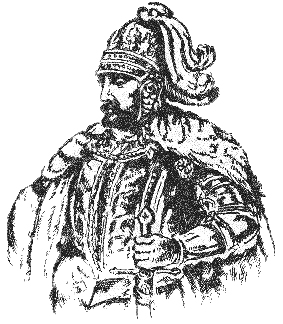
Liubartas or Demetrius of Liubar was Prince of Lutsk and Liubar (Volhynia) (1323–1383), Prince of Zhytomyr (1363–1374), Grand Prince of Volhynia (1340–1383), Grand Prince of Halych–Volhynia (1340–1349).
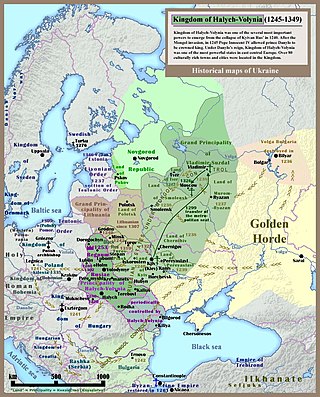
Leo I of Galicia was King of Ruthenia, Prince of Belz (1245–1264), Peremyshl, Galicia (1264–1269), and Kiev (1271–1301).
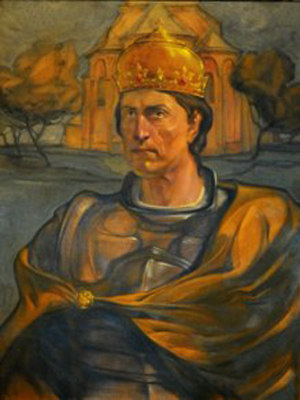
Andrew was the last king of Ruthenia in 1308–1323. He was the son of Yurii I (1252–1308) whom he succeeded on the throne of Galicia. His mother was Euphemia of Kuyavia. After the death of his father, he ruled the kingdom together with his brother Lev II. Though the kingdom was one state managed together, there are sources informing that Andrew was seated in Volodymyr and Lev II in Galicia.

Leo II of Galicia, also known as Lev Yurevich was Prince of Lutsk and Galicia, one of the last two Romanovichi kings of Rus`. He was a member of the senior branch of Monomakhovichi.

The Galicia–Volhynia Wars were several wars fought in the years 1340–1392 over the succession in the Kingdom of Galicia–Volhynia, also known as Ruthenia. After Yuri II Boleslav was poisoned by local Ruthenian nobles in 1340, both the Grand Duchy of Lithuania and the Kingdom of Poland advanced claims over the kingdom. After a prolonged conflict, Galicia–Volhynia was partitioned between Poland (Galicia) and Lithuania (Volhynia) and Ruthenia ceased to exist as an independent state. Poland acquired a territory of approximately 52,000 square kilometres (20,000 sq mi) with 200,000 inhabitants.
Euphrosyne of Opole was Polish Duchess and regent.
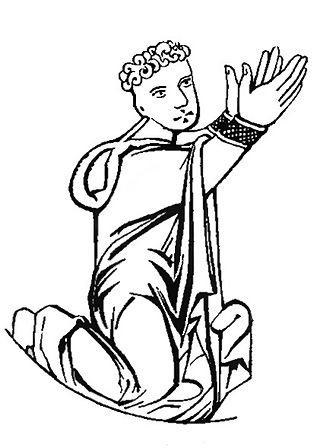
Casimir I of Kuyavia was a Polish prince and a member of the House of Piast. He was Duke of Kujawy after 1233, ruler over Ląd from 1239-1261, ruler over Wyszogród after 1242, Duke of Sieradz from 1247-1261, Duke of Łęczyca after 1247, and Duke of Dobrzyń after 1248.
Euphemia of Kuyavia was a Kuyavian princess and Queen consort of Galicia-Volhynia.
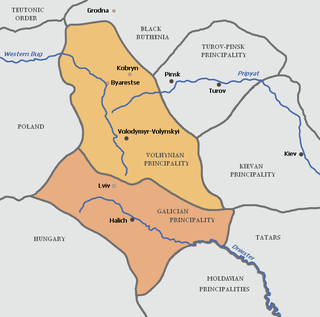
The Principality of Volhynia was a western Kievan Rus' principality founded by the Rurikid prince Vsevolod in 987 centered in the region of Volhynia, straddling the borders of modern-day Ukraine, Belarus, and Poland. From 1069 to 1118, it belonged to Izyaslavichi who primarily ruled from Turov. After losing Turov to Monomakhovichi in 1105, the descendants of Iziaslav Yaroslavovich for a few years continued to rule in Volhynia. From 1154 to 1199, the Principality was referred to as the Principality of Volodymyr when the Principality of Lutsk (1154–1228) was separated.
Vladimir II Yaroslavich was a Rus’ prince. He was prince of Halych.

Trojden I was a Polish prince, Duke of Czersk from 1310, ruler over Warsaw and Liw from 1313, and regent of Płock in the years 1336–1340. He was a member of the House of Piast.
Margaret of Masovia Polish: Małgorzata was Duchess of Pomerania and Brzeg, by her marriages to Casimir IV, Duke of Pomerania and then to Henry VII of Brzeg. She was a member of the House of Piast.
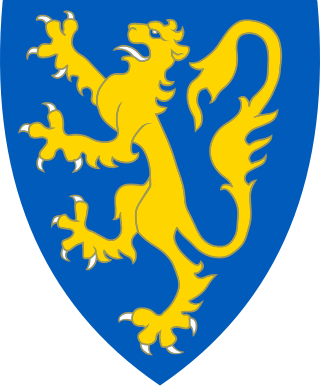
King of Ruthenia, King of Rus', King of Galicia and Lodomeria, Lord and Heir of Ruthenian Lands was a title of princes of Galicia and Volhynia, granted by the Pope.
The Metropolis of Halych was a metropolis of the Ecumenical Patriarchate of Constantinople in the Eastern Orthodox Church. It was erected on the territory of the Kingdom of Galicia–Volhynia in 1303 by Patriarch Athanasius I of Constantinople. The episcopal seat of the metropolis was in the city of Halych in the "Cathedral of the Assumption".
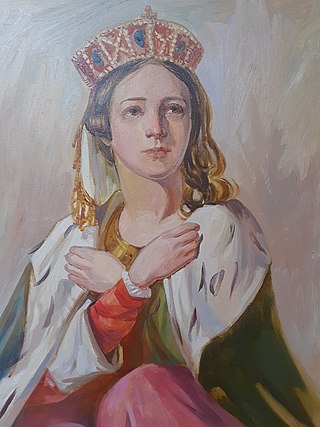
Constance of Hungary, was a Queen consort of Galicia and a Grand Princess of Kiev by marriage to Leo I of Galicia, Grand Prince of Kiev.
References
- 1 2 Srodecki, Paul; Kersken, Norbert; Petrauskas, Rimvydas (2022-11-25). Unions and Divisions: New Forms of Rule in Medieval and Renaissance Europe. Taylor & Francis. ISBN 978-1-000-68558-9.
- ↑ Basilevsky, Alexander (2016-04-11). Early Ukraine: A Military and Social History to the Mid-19th Century. McFarland. ISBN 978-0-7864-9714-0.
- ↑ Vernadsky, George; Karpovich, Michael (1943). A History of Russia: The Mongols and Russia, by George Vernadsky. Yale University Press.